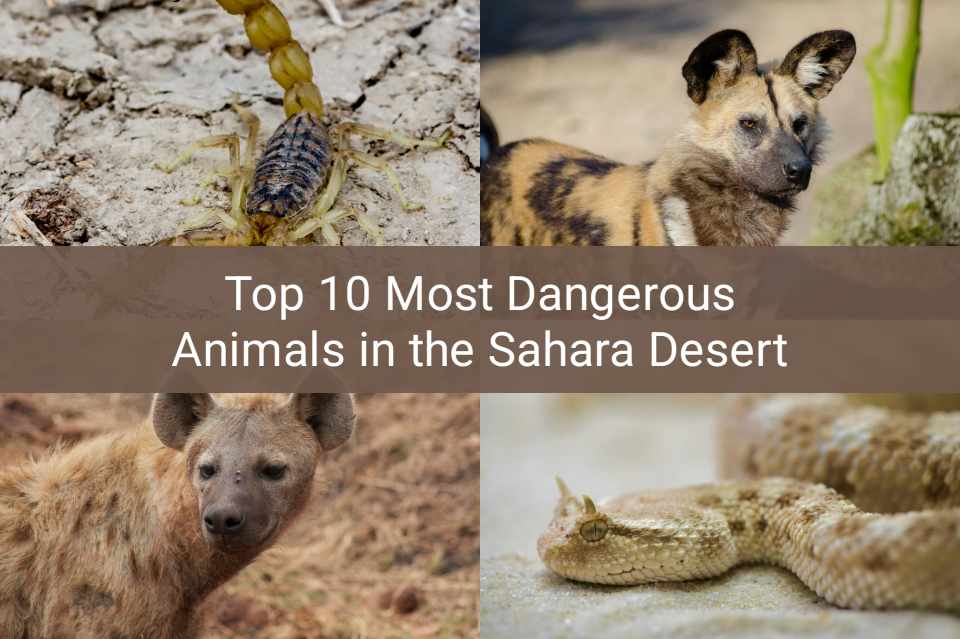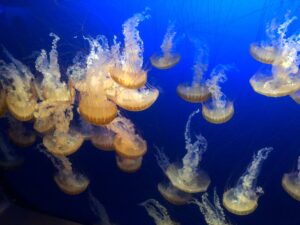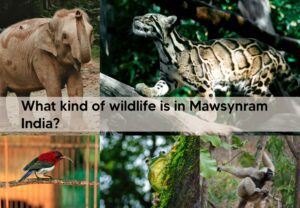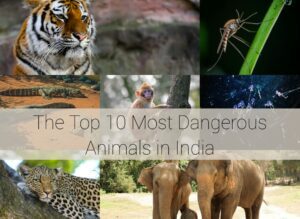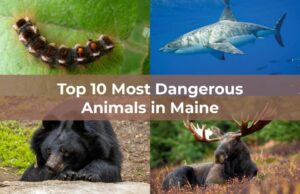The Sahara is a popular hot desert in North Africa. Like many other places, it is home to some wild animals.
Over 70 mammals and 100 reptiles live in the Sahara desert, and some of these animals can be dangerous.
In this article, we will look at the top 10 most dangerous animals in the Sahara Desert. You will also learn what makes them dangerous and how they survive in the hot desert conditions.
The Top 10 Most Dangerous Animals in the Sahara Desert
1. Deathstalker Scorpion

Scientific Name: Leiurus quinquestriatus
Deathstalker Scorpions are one of the most venomous scorpion species in the world. They are also known as the Palestine yellow scorpion, Omdurman scorpion, and Naqab desert scorpion.
A sting from a deathstalker can cause intense pain, fever, convulsions, and even death in severe cases.
Deathstalker Scorpions have adapted to survive in the hot weather conditions in the Sahara desert. In order to avoid the heat from the sun, they hide in burrows or under rocks.
They are also nocturnal, which means being active at night when temperatures are lower.
Their pale yellow exoskeleton not only helps them camouflage in the desert sand but also minimises water loss through evaporation.
2. Horned Viper

Scientific Name: Cerastes cerastes
The Horned Viper is also known as the Saharan horned viper or the desert horned viper. This viper is native to the deserts of Northern Africa.
Horned Vipers are another deadly inhabitant of the Sahara. A bite from this snake can cause swelling, haemorrhage, nausea, and vomiting and can be fatal if not treated on time.
The average total length of a Horned Viper from body to tail is 30–60 cm (12–24 in), and females might be larger than males.
Horned Vipers have two horns on the top of their heads. They can be identified by their yellowish, pale grey, reddish, or pale brown ground colour, which helps them camouflage in the sand to ambush their prey.
Most animals that survive in the desert have adapted to going long periods without water or consuming water from prey.
Aside from burrowing, Horned Vipers have adapted to withstand high temperatures.
3. Egyptian Cobra

Scientific Name: Naja haje
Egyptian Cobras are one of the most venomous snakes in North Africa. Their venom can be dangerous to humans and affects the nervous system.
In the Sahara desert, Egyptian Cobras are found in areas with oases, riverbanks, and rocky regions. They have also adapted to retreat into burrows or under rocks during the hot days.
Often given the title of one of the largest cobra species in Africa, Egyptian Cobras can reach 4.6 ft in length. The longest recorded was 8.5 ft in total length.
4. Sand Viper
Scientific Name: Cerastes vipera
Sahara sand vipers, or Avicenna vipers, are viper species that are native to the Sahara desert region. This snake is venomous, and a bite can cause severe pain, swelling, paralysis, or even death.
Just like many other wild animals in the Sahara desert, sand Vipers are nocturnal. Although they prefer to move around at night due to the cooler temperature, they have also adapted to survive under the hot day sun.
By staying buried in the sand, Sand Vipers ambush unsuspecting prey with little effort. They get most of their water from those prey.
5. African Wild Dog

Scientific Name: Lycaon pictus
Another dangerous predator that lives in the Sahara desert is the African Wild Dog, also known as the painted dog or Cape hunting dog.
These wild dogs have incredible bite force and can inflict serious injuries on prey. That is not the worst part; they hunt in packs and will go to extremes to bring down large prey.
African Wild Dogs can be identified by their large, round ears and long legs. They also have a unique mix of colours like black, brown, white, and yellow patches.
Currently, there are estimated to be around 6,600 adults in the wild. African wild dogs have been listed as endangered on the IUCN Red List since 1990.
6. Spotted Hyena

Scientific Name: Crocuta crocuta
Spotted Hyenas are one of the most popular wildlife found in Africa. These skilled hunters have powerful jaws that are easily one of the strongest bite forces in the animal kingdom.
Spotted Hyenas are also known as laughing Hyenas because of their ability to produce laughing sounds.
Just like wild dogs and wolves, hyenas hunt in packs and can run at high speed. They can be aggressive and sometimes steal prey from other predators in the wild.
In the desert, hyenas can survive for days without drinking water. They can get all the water needed for survival from prey.
7. Desert Crocodile
Scientific Name: Crocodylus suchus
Desert Crocodiles are adapted to survive in the arid desert environment of the Sahara. They are found particularly in Mauritania and Chad, where they can be seen around desert pools, caves, or burrows.
Another name for Desert Crocodiles is West African crocodiles or sacred crocodiles. They are smaller than Nile Crocs but are still as dangerous.
Nile Crocodiles are also found in the Sahara desert, and they are more aggressive than desert crocodiles.
In the Sahara desert, crocs still need water to survive. This is why they inhabit oases, gueltas, and underground water sources.
An example is the Guelta d’Archei in Chad, one of the most famous gueltas in the Sahara.
8. Saharan Cheetah
Scientific Name: Acinonyx jubatus hecki
Another wild animal that can be dangerous in the Sahara desert is the Saharan Cheetah. It is also known as the Northwest African cheetah.
This species of cheetah is rare and critically endangered. Saharan cheetahs are found throughout western and central Sahara and the Sahel.
Some of the countries where these cheetahs live in Africa include the Central African Republic, Chad, Algeria, Mali, and a few other places.
When compared to other species, the Northwest African cheetah has a shorter coat that is nearly white in colour. Their spots fade from black over the spine to light brown on the legs.
In the desert, this cheetah can reach 75 mph when hunting for fast prey like antelopes.
9. Black Widow Spider
Genus: Latrodectus
Black Widow Spiders are known to be dangerous to humans due to their venom. In the Sahara desert, they live in crevices, caves, and rocky areas.
Although black widow spiders are not as common as scorpions or snakes in the Sahara, they are highly adaptable to desert conditions.
Since black widow spiders are more active at night, they remain hidden during the heat of the day.
Bites are rare but can cause severe pain, vomiting, and excessive sweating for up to a week.
10. Desert Monitor
Scientific Name: Varanus griseus
Desert Monitors are large lizards that live throughout North Africa. They can grow up to 2 meters long.
While they are not completely venomous, they have sharp claws and a powerful bite that can cause serious injury. Their claws are suited for digging and climbing, so imagine getting a scratch. It will definitely be deep and hurt, so they can be dangerous.
Desert Monitors have mildly venomous saliva that is effective against prey but unlikely to affect humans.
Bonus
You have read this article to this point; I have a bonus animal for you.
Dromedary Camel

Scientific Name: Camelus dromedarius
Dromedary camels are well-suited for desert conditions, which is why they are commonly seen throughout the Sahara Desert as a means of transportation.
Although they can be gentle under the right conditions, they can also be dangerous. Dromedary camels can be temperamental and can deliver powerful kicks and bites.
Imagine receiving a kick from a 7-foot-tall, large animal weighing between 400 and 600 kg (880–1,320 lbs) or being stepped on. Yeah, that would hurt.
Camels are also known to spit when agitated. They can spit a mixture of saliva and stomach contents, which can be unpleasant, even if it is not harmful.
Conclusion
The Sahara Desert covers North Africa and is known for its extreme temperature and dry sand. Many dangerous animals, from venomous snakes to aggressive predators, live in the Sahara.
In this article, I have provided the top 10 most dangerous animals in the Sahara desert. You will learn about each animal and also see their pictures to easily identify them in the wild.
FAQs
Are all animals in the Sahara Desert dangerous?
Not all animals in the Sahara are dangerous. Many are harmless, like antelope, hyrax, fennec fox, and others.
Are there any endangered species in the Sahara Desert?
Yes, the Saharan Cheetah is one of the endangered species in the Sahara Desert. There are many other wild animals with declining populations in the desert.

Hi, I’m Louis Ojibe, and I grew up around wildlife in Africa. I have always been fascinated by animals and nature across the world.
As a child, my parents used to take me to see wild animals like lions, elephants, gorillas, tortoises, and many others at our local zoo.

